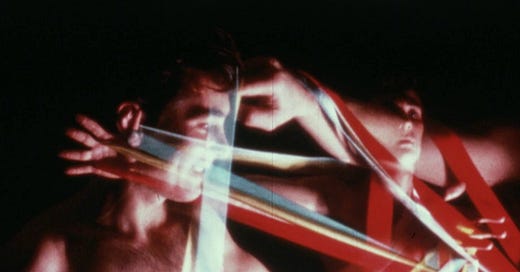The Illiac Passion (Gregory Markopoulos, 1967):
The Illiac Passion is my favorite Markopoulos film thus far, providing an inflection point between surrealist semi-narrative shorts like Christmas, USA and the glistening superimposition films he made after decamping to Greece with his partner Robert Beavers.
Part of my affinity for this particular film is that it provides moving theories for Markopoulos’ abiding interest in classical aesthetics. Where many of the early shorts I’ve seen focus solely on Markopoulos’ own psyche, negotiating his sexuality through psychosexual personal mythologizing, The Illiac Passion is firmly an ensemble piece, adapting a pantheon of Greek myths through figures of the 1960s New York arts scene. The experience is one that’s more classical than contemporary, using the denaturalizing effect of avant-garde form to perform cinematic time travel.
One of the ways Markopoulos achieves this is by positioning himself as an orator, reading a fragmented version of Aeschylus’ Prometheus Bound that runs in dialogue with the adaptations onscreen. The text of this incantatory voice-over, which rarely includes complete sentences and repeats specific words and phrases without concern for linguistic structure (e.g. he might repeat the last word of one phrase and the first of another) is musical in nature, reveling in the sensual possibilities of the text while relying on the audience’s basic familiarity with the Prometheus myth for broad-strokes comprehension.
This same logic guides The Illiac Passion’s imagery, which liberally intercuts and superimposes its chosen tales. These take place in a wide range of aesthetic contexts. Some of them unfold in a black void, while others clearly take place in New York City, either in the actors’ apartments or at various Manhattan landmarks. This is a handy way to abstract mid-century New York, and the sense of peeling back layers of reality creates lyrical intrigue. It’s often difficult to discern which myth we’re seeing onscreen, but of the ones I caught, I’m certain that one with a man lying on the floor with a mirror is Narcissus, another which features the memorable image of a young woman superimposed with flowers is Persephone, two characters with their backs to each other (and inexplicably holding turtles) are Orpheus and Eurydice, and of course, the naked man engulfed in flames Prometheus. Like the Aeschylus text, the narrative of these myths is deconstructed, the story distilled to its erotic, expressive overtones.
As for what Markopoulos is doing, there’s an emotional core to the act of mythologizing his friends, immortalizing them in timeless, idiosyncratic imagery. From the perspective of 2025, where we know that many of these figures, including Markopoulos himself, died of AIDS complications, there’s a memorializing of a specific time and place that’s quite moving. We also know that Ancient Greece had remarkably different conceptions of sexuality, so by creating an aesthetic experience that feels pulled from a bygone historical era, Markopoulos turns his inner circle into a Dionysian alternative to the rules of pre-Stonewall New York. He manages something quite remarkable, creating a film that’s incredibly materialist, tangibly tied to his friends and their urban routines, while simultaneously transcendent in the most literal sense of the word.
The Death of Louis XIV (Albert Serra, 2016):
A film about the procedural bodily decay and eventual death of Louis XIV is admittedly a stretch for a Pride Month review, but this is a film that displays a strong queer sensibility, and as a demythologizing of history, feels like an interesting pairing with Markopoulos’ film.
Over the past year, I’ve grown to love the work of Albert Serra, whose films display seemingly limitless conceptual and sensual possibility. His concept-driven works, which often start as theater, performance art, or gallery installations, draw from a range of queer reference points (Visconti’s obsolescent aristocracy, Pasolini’s earthy, promiscuous mythological adaptations, Fassbinder’s Brechtian deployment of classical narrative) to create problematized and confrontationally erotic cinematic spaces.
The Death of Louis XIV, which stars Jean-Pierre Leaud in the lead role, is emblematic of Serra’s approach. As opposed to focusing on the majesty of Versailles or the political machinations happening in the wake of Louis’ declining health, Serra’s film perversely takes place almost entirely in Louis’ bedchamber, where he groans for help, is attended to by various sycophantic subjects, and rots from gangrene. Despite the film’s mundane premise, the narcotic musicality and immaculate tenebrist lighting of Serra’s filmmaking is gripping. The central conflict is that The Death of Louis XIV is intensely physical, yet entirely symbolic. As his leg slowly necrotizes, Louis’ body is easily read as a victim of the corrosive monarchy, the pageantry bestowed upon his position, and even the limitations of his time (e.g. primitive medical technology).
While this in itself would make for an interesting film, Serra goes multiple steps further. By shooting in static close-ups, and in shrouded, Costa-esque chiaroscuro lighting, Serra formally complicates the temporality of the film. He creates a liminal shadow-world, cultivating conditions for anachronistic signifiers. Jean Pierre-Leaud’s meta-textual role as art cinema royalty is the most prominent of these anachronisms. When Serra shoots long takes of Leaud’s face, is the image a pastiche of contemporaneous Baroque painting, a “freeze-frame” homage to Leaud’s most iconic role (the actual The 400 Blows tribute near the end of the film is incredibly moving), or an example of 21st-century durational cinema? In fact, the heaviness of the meta-text, which makes the film feel like a portrait of an actor, even suggests a Warholian Screen Test. A similar ambiguity can be observed in the title, which is a play on both Voltaire and Rossellini. The Death of Louis XIV exists in all of these eras at once, forming a connective tissue between all of its mediums and periods. Its form then touches on everything from the death of cinema to the persistent influence of European imperialism on Western artistic traditions.
One byproduct of Death’s dense conceptualization is that Serra emphasizes the powerlessness of the body. Bedridden, trapped under the literal and metaphorical weight of period attire, and stuck in an extended death ritual, even the name of the character and actor feels like more than any body can reasonably handle. As doctors bleed, rub, and force-feed (only half-successfully) Louis, these perpetual disturbances are presented as a Beckettian torture chamber. The film’s final punchline, a scene of literal disembowelment, is the actual nail in the coffin for the body at its gravitational center. The Death of Louis XIV depicts the cruel ravages of time, and a Western society crumbling from the corrosiveness of its own toxicity. It’s a visceral film about living through the end of something, and in many ways, it’s the perfect movie for 2025.
The Death of Louis XIV is available to stream on Kanopy and VOD.








Such an evocative description of Louis XIV's body in its final moments of torment. I felt viscerally affected by your language in this review.